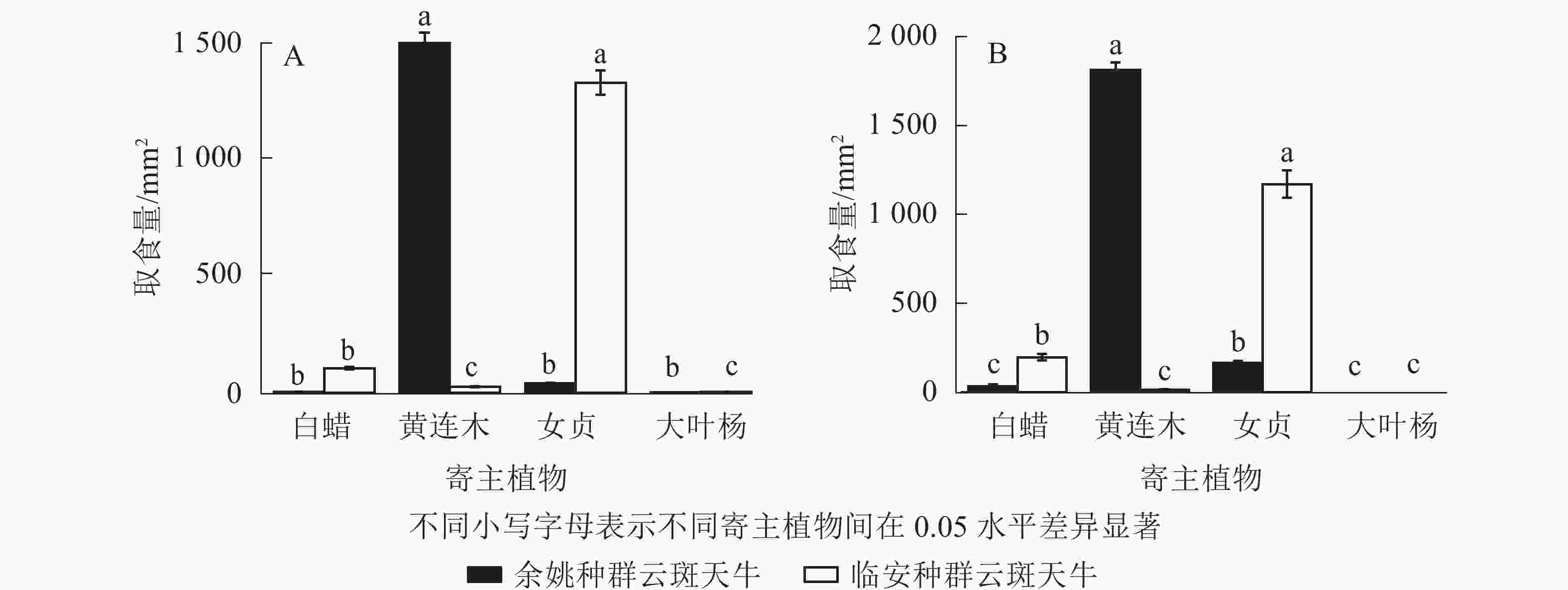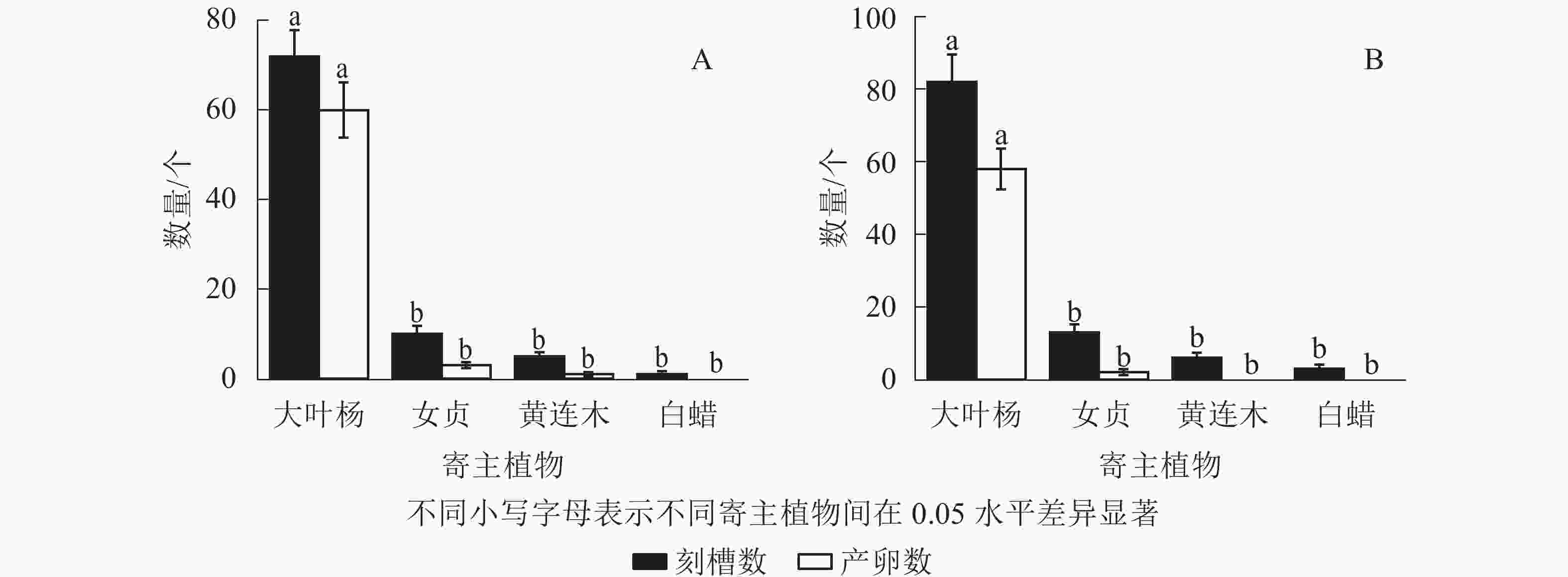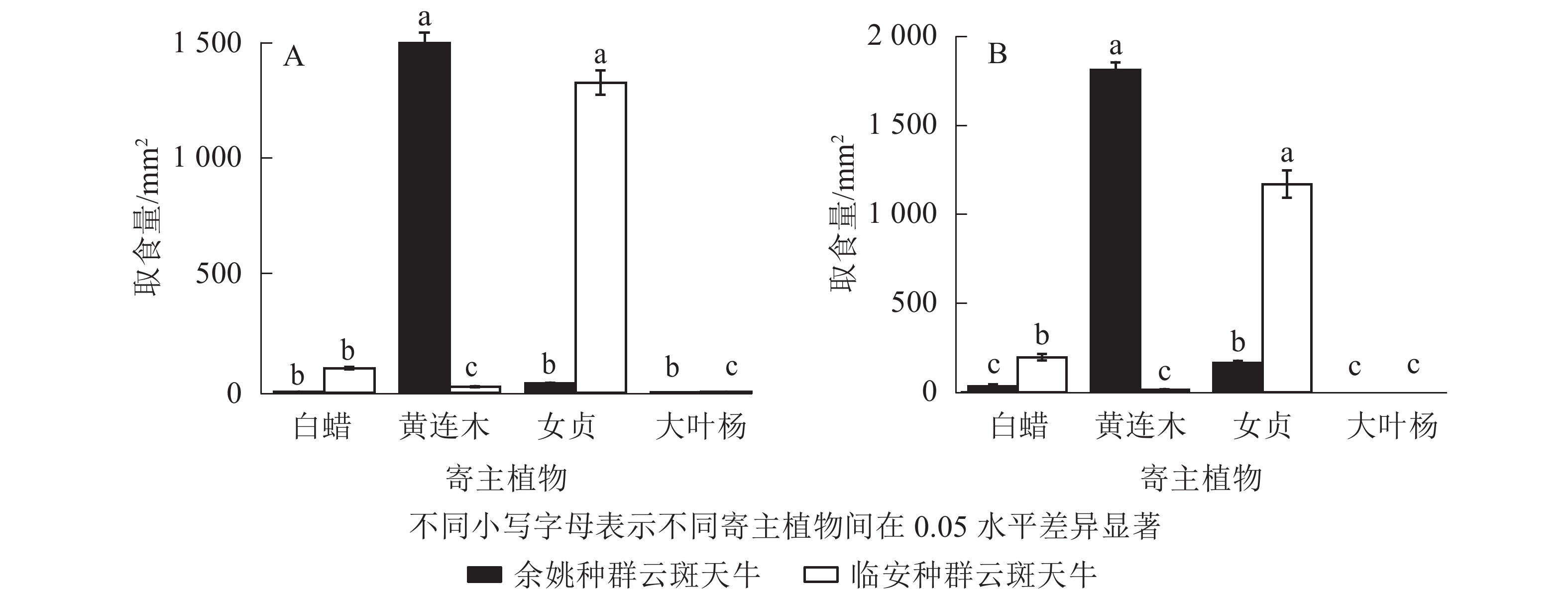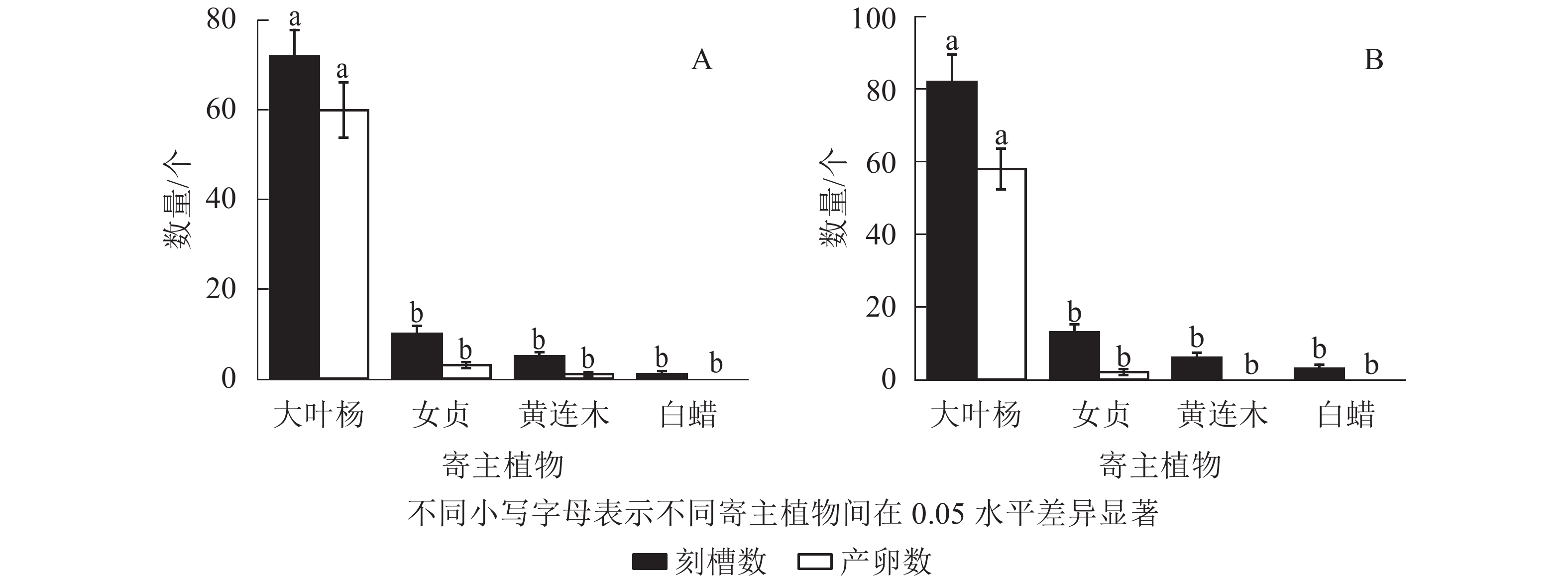-
云斑天牛Batocera horsfieldi是中国重要的林业蛀干害虫,隶属于鞘翅目Coleoptera天牛科Cerambycidae,也称为云斑白条天牛,分布范围广,为害毛白杨Populus tomentosa、核桃Juglans regis、油橄榄Oleaeuropaea、板栗Castanea mollissima、白蜡Fraxinus chinensis等近百种阔叶林木和果树[1]。由于云斑天牛生活隐蔽,抗逆性强且防治困难,一旦发生会对许多天然林、经济林和城市园林树木造成毁灭性危害[2-4]。在中国有害物风险分析中,云斑天牛有害生物风险分析(PRA)值为2.04,属于高度危险性林业有害生物[4-5]。
昆虫的取食行为是昆虫在接受内外信息后,由神经系统和肌肉系统作出的综合反应,表现出摄取食物以及与此相关的一系列活动[6]。寄主植物是影响植食性昆虫取食和产卵的重要因素,其中包括寄主植物种类、数量及寄主植物挥发物、遗传因素等[7]。昆虫的取食行为主要受到2个因素的影响:营养需求和食物适口性[8]。昆虫产卵行为的总体原则是最有利于其后代生活,最大限度提高其种群存活数量[9-10],故取食和产卵行为均会表现出一定的选择性。昆虫对于植物的正趋向性取食和产卵可称为取食偏好性和产卵偏好性。
植食性昆虫都能利用植物挥发物来找到寄主植物,完成生长发育和繁殖,同时也可避免误食非寄主植物而引起中毒或者营养不良[11]。尹姣[12]、李超等[13] 研究显示:当几种不同的寄主植物同时存在时,昆虫取食行为具有一定的选择性。朱林慧等[14]的研究表明:为害核桃种群的云斑天牛对原寄主核桃有明显的取食偏好性,且对原寄主具有较强的产卵选择性和依赖性。高瑞桐等[15]、钱范俊等[16]的研究结果则表明:蔷薇科Rosaceae植物是为害杨树种群的云斑天牛成虫的喜食树种,但云斑天牛在这些寄主植物上取食补充营养、交配后,会转移至原寄主杨树上刻槽产卵;如果强制天牛取食杨树来补充营养,天牛则不能产卵。目前,对于不同生长环境对云斑天牛取食和产卵偏好的影响研究较少。本研究探讨不同种群云斑天牛成虫对大叶杨P. lasiocarpa、女贞Ligustrum lucidum、白蜡、黄连木Pistacia chinensis等4种寄主植物的取食偏好和产卵偏好差异,分析其中的原因,为开发云斑天牛植物源引诱剂提供理论依据与技术支持。
-
余姚种群云斑天牛成虫:采集地为浙江省余姚市沿海防护林(30°20′N,121°18′E,平均海拔2.2 m)。该地为大叶杨、女贞、白蜡、黄连木、柳树Salix babylonica、夹竹桃Nerium indicum、海滨木槿Hibiscus hamabo、木麻黄Casuarina equisetifolia和苦楝Melia azedarach等植物的混交林带,林地地势较为平坦,其中大叶杨、女贞、白蜡和黄连木受到云斑天牛为害,平均树高约10 m,平均胸径约30 cm,林下无其他植被。将采集到的云斑天牛成虫置于捕虫铁丝网内带回室内,室内环境下将其饲养于120 cm×60 cm×180 cm的养虫笼内。笼内放有沿海防护林常见树木(大叶杨、女贞、白蜡和黄连木)枝条,室内温度为24~32 ℃。
临安种群云斑天牛成虫:该种群云斑天牛为3 a前来自余姚种群,经历3 a临安苗圃地(30°23′N,119°72′E)寄主植物适应和驯化。该地植物种类有白蜡、柳树、桑树Morus alba、苦楝和山核桃Carya cathayensis等。将采集到的云斑天牛成虫置于捕虫铁丝网内带回室内,室内环境下将其饲养于120 cm×60 cm×180 cm的养虫笼内,笼内放有苗圃地常见树木(白蜡、柳树、桑树、苦楝和山核桃)枝条,室内温度为24~32 ℃。
-
供试植物为白蜡、黄连木、女贞、大叶杨。于2020年7月采自余姚市沿海防护林。将直径2 cm左右的健康枝条和直径15 cm左右的树干带回室内,再截成30 cm,用保鲜膜包裹断面,以减少枝条和树段水分的散失,供取食和产卵试验使用。
-
选择3对余姚种群云斑天牛成虫,饥饿24 h后,放入120 cm×60 cm×180 cm养虫笼内,笼内4个角落放有4段同一寄主植物枝条。枝条为30 cm (长) ×2 cm(直径),试验时间为48 h,温度为24~32 ℃,光周期14 h∶10 h (光照∶黑暗)。用透明硫酸纸记录枝条上的取食刻痕,用坐标纸测量取食面积。重复5次。临安种群云斑天牛成虫无选择性取食试验方法与余姚种群相同。
-
选择3对余姚种群云斑天牛成虫,饥饿24 h后,放入120 cm×60 cm×180 cm养虫笼内,笼内4个角落分别放有4种寄主植物各1段枝条,4种寄主植物分别为:白蜡、黄连木、女贞、大叶杨。枝条为30 cm (长)×2 cm (直径),试验时间为48 h,温度为24~32 ℃,光周期为14 h∶10 h (光照∶黑暗)。用透明硫酸纸记录枝条上的取食刻痕,用坐标纸测量取食面积。重复5次。临安种群云斑天牛成虫选择性取食试验方法与余姚种群相同。
-
将3对性成熟的余姚种群云斑天牛成虫放入120 cm×60 cm×180 cm的养虫笼,笼中放有单一树种的3年生树段4段。试验时间为1周,温度为24~32 ℃,光周期为14 h∶10 h (光照∶黑暗)。记录刻槽数和产卵数。重复5次。临安种群云斑天牛无选择性产卵试验方法与余姚种群相同。
-
将3对性成熟的余姚种群云斑天牛成虫放入120 cm×60 cm×180 cm的养虫笼,每个笼中放有4个供试树种的3年生树段各1段。试验时间为1周,温度为24~32 ℃,光周期为14 h∶10 h (光照∶黑暗)。记录刻槽数和产卵数。重复5次。临安种群云斑天牛选择性产卵试验方法与余姚种群相同。
-
采用SPSS 19.0进行统计分析。对云斑天牛成虫不同寄主植物上取食面积、刻槽数和产卵数进行单因素方差分析(one-way ANOVA)和多重比较。多重比较采用LSD法,α=0.05。采用Origin软件绘图。
-
图1A显示:在选择性条件下,余姚种群云斑天牛成虫在黄连木、白蜡、女贞和大叶杨上的取食量分别为(1 520.00±34.79)、(4.00±1.14)、(40.66±3.60)和(1.66±0.49) mm2;余姚种群云斑天牛成虫对4种植物的取食量差异显著(F3,16=1 849.70,P<0.05),对黄连木的取食量显著大于其他3种植物。临安种群云斑天牛成虫在黄连木、白蜡、女贞和大叶杨上的取食量分别为(26.00±2.55)、(106.30±5.29)、(1 347.33±51.95)和(3.60±0.69) mm2;临安种群云斑天牛成虫对4种植物的取食量差异显著(F3,16=623.01,P<0.05),对女贞的取食量显著大于白蜡、黄连木和大叶杨。

Figure 1. Selective feeding (A) and non-selective feeding (B) situation of B. lineolata on different host plants
图1B显示:在无选择性条件下,余姚种群云斑天牛成虫在黄连木、白蜡、女贞和大叶杨上的取食量分别为(1 815.50±42.13)、(33.75±9.38)、(163.25±13.64)和0 mm2;余姚种群云斑天牛成虫对4种植物的取食量差异显著(F3,16=1 504.29,P<0.05),对黄连木的取食量显著大于白蜡、女贞和大叶杨。临安种群云斑天牛成虫在黄连木、白蜡、女贞和大叶杨上的取食量分别为(12.75±4.32)、(196.00±19.75)、(1 173.00±75.54)和0 mm2,对4种植物的取食量差异显著(F3,16=205.06,P<0.05),对女贞的取食量显著大于白蜡、女贞和大叶杨。
-
图2A显示:选择性条件下,余姚种群云斑天牛成虫在黄连木、白蜡、女贞和大叶杨上的刻槽数分别为(5.00±0.89)、(1.00±0.63)、(10.00±1.79)和(72.00±5.87)个,产卵数分别为(1.00±0.45)、0、(3.00±0.63)和(60.00±6.19)个;余姚种群云斑天牛成虫在4种植物上的刻槽数和产卵数均差异显著(刻槽数:F3,16=115.65,P<0.05;产卵数:F3,16=78.55,P<0.05),在大叶杨上的刻槽数和产卵数显著大于其他3种植物。

Figure 2. Selective(A) and non-selective(B) ovipositi behavior of B. lineolata in Yuyao population on different host plants
图2B显示:无选择性条件下,余姚种群云斑天牛成虫在黄连木、白蜡、女贞和大叶杨上的刻槽数分别为(6.00±1.30)、(3.00±1.10)、(13.00±2.17)和(82.00±7.64)个,产卵数分别为0、0、(2.00±0.84)和(58.00±5.66)个;余姚种群云斑天牛成虫在4种植物上的刻槽数和产卵数均差异显著(刻槽数:F3,16=66.60,P<0.05;产卵数:F3,16=100.63,P<0.05),在大叶杨上的刻槽数和产卵数显著大于其他3种植物。
图3A显示:选择性条件下,临安种群云斑天牛成虫在黄连木、白蜡、女贞和大叶杨上的刻槽数分别为(3.00±0.89)、(5.00±0.71)、(10.00±1.76)和(35.00±5.22)个,产卵数分别为(1.00±0.55)、(2.00±1.05)、(6.00±1.22)和(22.00±4.51)个;临安种群云斑天牛成虫在4种植物上的刻槽数和产卵数均差异显著(刻槽数:F3,16=22.71,P<0.05;产卵数:F3,16=16.37,P<0.05),在大叶杨上的刻槽数和产卵数显著大于其他3种植物。
图3B显示:无选择性条件下,临安种群云斑天牛成虫在黄连木、白蜡、女贞和大叶杨上的刻槽数分别为(3.00±0.89)、(10.00±1.90)、(13.00±2.30)和(30.00±3.85)个,产卵数分别为0、(5.00±2.12)、(3.00±0.71)和(25.00±3.08)个;临安种群云斑天牛成虫在4种植物上的刻槽数和产卵数均差异显著(刻槽数:F3,16=21.44,P<0.05;产卵数:F3,16=35.56,P<0.05),在大叶杨上的刻槽数和产卵数显著大于其他3种植物。
-
寄主植物对昆虫的取食行为、生长发育和种群繁殖都有重要影响[17]。昆虫在寄主植物上较短的发育期和较强的繁殖力能反映其对寄主的适应性[18-19]。本研究结果显示:不同种群云斑天牛对寄主植物的取食存在显著差异,表现出不同的取食偏好性。余姚种群云斑天牛对4种寄主植物的取食偏好程度从大到小依次是黄连木、女贞、白蜡、大叶杨,而临安种群云斑天牛则是女贞、白蜡、黄连木、大叶杨。余姚种群云斑天牛和临安种群云斑天牛的产卵偏好性顺序基本一致。余姚种群云斑天牛对4种寄主植物的产卵偏好程度从大到小依次是大叶杨、女贞、黄连木、白蜡,而临安种群云斑天牛对4种寄主植物的产卵偏好顺序则是大叶杨、女贞、白蜡、黄连木。根据调查,余姚沿海防护林主要植物种类有大叶杨、柳树、黄连木、女贞等4个树种,余姚种群云斑天牛成虫聚集在黄连木枝条上取食为害,在大叶杨树干上产卵为害。临安苗圃地植物种类是白蜡树、柳树、桑树、苦楝和山核桃等5个树种,临安种群云斑天牛成虫在白蜡树枝条上取食为害,在白蜡树树干上产卵为害。
临安种群云斑天牛在3 a前从余姚沿海防护林中采集后,释放到临安苗圃地,已经在临安的寄主植物中驯化和适应了3 a。本研究结果显示:临安种群云斑天牛取食偏好已经发生了改变,原本喜欢取食黄连木,经过对新寄主植物适应后,喜欢取食女贞。我们推测,云斑天牛经过一定时期的驯化后,为适应生长环境,取食行为会发生改变。林强等[20]通过研究发现:4个不同地区茶尺蠖Ectropis obliqua种群在取食适应性方面存在显著差异。莫让瑜等[21]通过研究发现:不同地理种群的南方大斑蝥Mylabris phalerata成虫偏嗜的食物种类有差异。
在产卵行为上,2个种群云斑天牛并没有发生显著的变化。虽然各寄主植物一般都有天牛正常生长发育所必需的营养成分,但其总含量或相对含量则可能存在较大的差异,这种差异性足以影响天牛的正常生长发育或繁衍后代[15],同时植食性昆虫的产卵量会随着寄主植物的改变而发生变化[15, 22]。2个种群云斑天牛成虫均喜欢在大叶杨上产卵,但不取食大叶杨,说明大叶杨是云斑天牛幼虫的蛀干寄主而不是成虫补充营养寄主。杨洋等[23]通过试验发现:四川种群云斑天牛对青冈Cyclobalanopsis glauca、桉树Eucalyptus、核桃等3种补充营养寄主均有一定取食选择,但对杨树取食为0。云斑天牛成虫无选择杨树寄主的取食倾向。
综上所述,经过临安苗圃地不同地理环境寄主植物驯化和适应,余姚种群云斑天牛为适应新地理环境,寄主取食行为已经发生改变,而新寄主植物对云斑天牛的生长发育有何影响有待于进一步研究。产卵行为在不同地理种群间保持了较高的一致性,说明需要除了满足自身适应性,还要满足后代对寄主植物的适应性,同时也体现出多食性昆虫对寄主植物复杂的适应性。植物挥发物是植食性昆虫寻找寄主植物的重要信号物质,因此,需要加强对多食性昆虫对寄主植物信号物质复杂的感受机制研究,为开发云斑天牛引诱剂奠定理论基础。
Differences in feeding and oviposition behavior of different populations of Batocera horsfieldi
doi: 10.11833/j.issn.2095-0756.20210366
- Received Date: 2021-05-12
- Rev Recd Date: 2021-09-26
- Available Online: 2021-11-15
- Publish Date: 2022-02-14
-
Key words:
- forest protection /
- Batocera horsfieldi /
- host plant /
- feeding /
- oviposition /
- preference
Abstract:
| Citation: | ZHENG Kaiwen, WU Shouxin, ZHANG Dongyong, et al. Differences in feeding and oviposition behavior of different populations of Batocera horsfieldi[J]. Journal of Zhejiang A&F University, 2022, 39(1): 159-165. DOI: 10.11833/j.issn.2095-0756.20210366 |











 DownLoad:
DownLoad:

